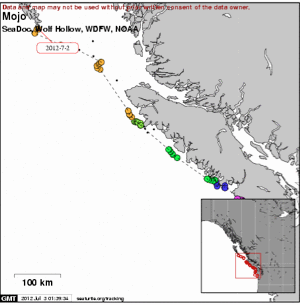satellite tag
New study reveals seal pups learn foraging skills at early age
Dec/19/12 10:17 AM
SeaDoc Society has just released the findings of a study of 20 satellite tagged weaned harbor seal pups, half of whom were tagged in the wild and half after rehabilitation. The study shows that rehabbed pups travel greater distances than wild pups foraging for food. Read this fascinating story here.
West Seattle stranded seal pup Sandy was satellite tagged and released in late January this year after a lengthy rehab at PAWS. Hundreds of people logged onto SeaDoc’s site and followed her progress and travels around Puget Sound until she was found dead in April, entangled in derelict fishing gear. Her death put a face on the dangers of marine debris and pollution and a beach cleanup was held in her honor. Read about Sandy here.
West Seattle stranded seal pup Sandy was satellite tagged and released in late January this year after a lengthy rehab at PAWS. Hundreds of people logged onto SeaDoc’s site and followed her progress and travels around Puget Sound until she was found dead in April, entangled in derelict fishing gear. Her death put a face on the dangers of marine debris and pollution and a beach cleanup was held in her honor. Read about Sandy here.
Mojo the Steller sea lion pup makes it to Alaska rookeries
Jul/12/12 05:48 AM
Mojo, the Steller sea lion pup who was rescued on Washington’s outer coast, rehabbed at Wolf Hollow in the San Juans, and released back to the wild fitted with a satellite tracking device has made it all the way to the Alaska rookeries. A rookery is where sea lions (or seals) gather in large numbers to give birth, nurse their young and mate. Mojo has travelled 1484 km (over 922 miles) since his release on May 29th. Read all about Mojo here.
PUPDATE 7/23
Mojo continues to cruise northward along Alaska’s shoreline. As of yesterday, the satellite picked up his signal near Sitka. It looks like he is thriving in the wild. Soon, however, we will lose contact with him as he molts his fur and the glued-on tag falls off.
PUPDATE 7/23
Mojo continues to cruise northward along Alaska’s shoreline. As of yesterday, the satellite picked up his signal near Sitka. It looks like he is thriving in the wild. Soon, however, we will lose contact with him as he molts his fur and the glued-on tag falls off.
Mojo on the move again - sighted in Canada
Jul/01/12 06:37 AM
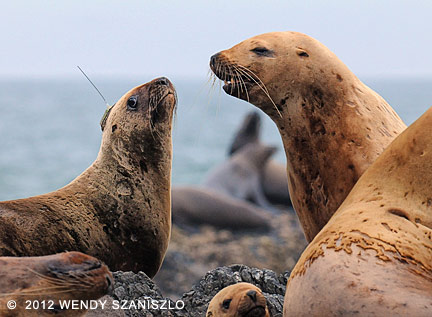
A marine mammal biologist (who also volunteers with the British Columbia Marine Mammal Stranding Response Network) was doing routine re-sights of branded animals when she noticed Mojo with his satellite tag on a very busy and popular Steller haulout site, Long Beach Rocks. This is one of a number of haulouts in and adjacent to the Pacific Rim National Park. Long Beach is considered a year round haulout for Stellers. Biologist Wendy Szaniszlo conducted a 3-yr study of the seasonal abundance and distribution of sea lions in the park preserve. Stellers are considered a Species of Special Concern under Canada’s Species at Risk Act. Wendy reports that Mojo was observed in the “middle of the action”, which means he seems to have adapted well to life back in the wild.
You can follow Mojo’s travels on SeaDoc Society’s website and receive almost daily updates on his location. Since this photo was taken, he is on the move once again and headed further north, well beyond Vancouver Island into Queen Charlotte Sound. As you can see from the photo, this is the time of year when sea lions molt their fur. Soon, Mojo’s glued-on tag will fall off as he sheds his old coat and grows a brand new silky one and transmissions will cease. Many thanks to Wendy for sharing this photo! Read more about Mojo’s story here.
PUPDATE: 7/3/12
A satellite picked up a ping from Mojo’s transmitter yesterday and he has made it to Haida Gwaii (formerly known as the Queen Charlotte Islands), which consists of about 150 islands off the coast of British Columbia. More specifically, his location appears to be Gwaii Hanas National Park Reserve.
Mojo has travelled 962 km (over 598 miles) since released back to the wild on May 29th.
Mojo the sea lion an international traveler
Jun/07/12 08:26 AM
Mojo, the Steller sea lion pup released on the outer coast of Washington last week, quickly made his way north and has settled into Canadian waters. The most recent satellite hits place him near Tofino on Vancouver Island. The Tofino/Ucleulet area is known for large concentrations of Stellers, a threatened species. In only 7 days, he has travelled 310 km (192 miles). Mojo would have most likely been born in a Steller sea lion rookery located in Oregon or Alaska. Since he was at least 6 months old when rescued from Pacific Beach in Washington, it is conceivable that he spent time in Canada with his mom. Or perhaps he hooked up with another Steller in Washington who was headed north. We will never know why he chose to travel to Canada, but are relieved that he has found members of his own species to hang out with - and in a much safer territory than around the Columbia River at Oregon and Washington’s border, where up to 20 sea lions have been shot (see related story).
Follow Mojo’s travels on SeaDoc Society’s website.
Follow Mojo’s travels on SeaDoc Society’s website.
Mojo the Steller sea lion pup returned to the wild
Jun/01/12 08:22 AM
On February 16, 2012 WDFW Marine Mammal Investigations responded to a Steller sea lion pup at Pacific Beach. This is believed to be the same Steller pup that was reported numerous times in other locations over a two week period with sightings on the Long Beach Peninsula and in Ocean Shores. The pup was weak, dehydrated, emaciated, and appeared to be separated from his mother. The pup, named Mojo, was transferred the following morning to Wolf Hollow Rehabilitation Center for stabilization, treatment, and care. When he arrived at Wolf Hollow he weighed in at 80 lbs and within the first ten days he gained 11 lbs. After three and a half months of rehabilitation, Mojo weighed in at over 255 lbs., and was strong, healthy, and ready for release. He was to be fitted with a satellite transmitter that is glued to his pelt; this is a non-invasive procedure that does not harm the animal. When Mojo molts, the tag will fall off. However, we expect to receive data regarding his movements and foraging patterns for the next 3-5 months.
Mojo’s Release Day
At 4am on May 29, Seal Sitters’ lead investigator Robin Lindsey rendezvoused with WDFW-MMI biologist Dyanna Lambourn and her dedicated intern Erin D’Agnese for the trip up to Anacortes to catch the San Juan Island ferry. From the boat, as we approached Friday Harbor, we spied a pod of white-sided dolphins. Upon arrival at Wolf Hollow, the team discussed the game plan to sedate and transport Mojo on his long journey back home to the Washington coast, where he was rescued months before. Mojo, expecting his fish breakfast, instead was sedated, examined and fitted with flipper tags for identification purposes and a satellite tag.
The team eagerly carried the snoozing Mojo to the huge cage on the back of WDFW’s pickup. It was still a long day ahead for Mojo and WDFW who would transport him all the way out to the ocean. Within a few minutes, Mojo began to stir in the cage, sporting his fancy satellite hat. As the truck travelled along the highway, he looked curiously out at the moving landscape. We had many, many hours to go. Dyanna’s phone rang and it was a biologist from the outer coast, reporting a live sea otter who had been on the beach since late the day before. Numerous phone calls later, the logistics of getting the animal, suffering from seizures, to US Fish and Wildlife in Olympia were arranged. Dyanna would swing by on our way south to quickly assess and make a determination of the animal, most likely suffering from protozoal encephalitis. Another call came in about a dead harbor seal pup on the outer coast. We would pick the pup up for necropsy after releasing Mojo. The phone rang again - there was a harbor seal pup resting on the beach near our destination. This was just a glimpse into the demanding 24/7 daily life of this WDFW marine mammal biologist and the interns who not only juggle school and jobs, but devote countless hours volunteering for Fish and Wildlife.

Following Mojo’s release, we scoured the beach south along the ocean for the seal pup reported earlier in the day. This is harbor seal pupping season along the outer coast, and pups use beaches that vehicles are allowed to drive upon. Last year, a pup was run over on the Fourth of July. We could not find the pup, but did find stakes and “Protected Marine Mammal” tape and headed to the highway. Arriving bleary-eyed back at our respective homes around midnight, it was an exhausting, but incredibly exhilarating day.
Mojo will provide invaluable data to the network. Sign up here for email updates showing a map of his travels. This case has been made possible, in large part, through the John H. Prescott Marine Mammal Rescue Assistance Grant Program. Tracking this animal would not be possible without the collaboration of several network groups which include: Washington Department of Fish and Wildlife Marine Mammal Investigations, Wolf Hollow Rehabilitation Center, SeaDoc Society, and NOAA's Protected Resources Division.
Divers recover seal pup Sandy's body for necropsy
Apr/05/12 09:49 PM
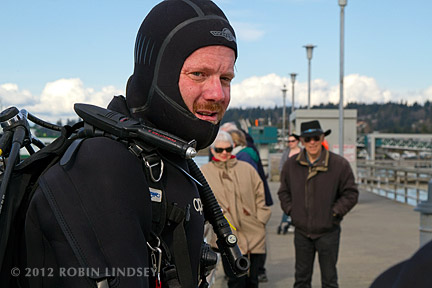
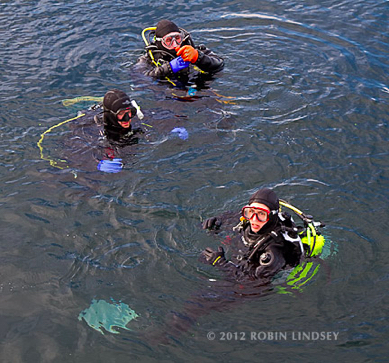
Yesterday, while the MaST team searched the cold waters below (photo right), Seal Sitters’ lead investigator was stationed up on the pier to keep them safe from fishermen’s casts. She had an enlightening conversation with lone fisherman Nick about derelict lines and lures. According to Nick, there are a number of large tires that have been sunk off the pier in order to create habitat for fish. While fish have indeed become abundant in this habitat, the problem is that lures are constantly getting caught on the rubber tires and fishermen can’t reel them back in. Much to the frustration of the fishermen, the lines then have to be cut, leaving a maze of ebbing monofilament, hooks and lures which put marine mammals and sea birds at great risk. Nick said that Des Moines had sunk tires as well years ago, but finally removed them all. It was his and other fishermen’s opinion that Edmonds should follow suit. When the MaST team completed the dive, Sandy in tow, the divers mentioned the amazing amount and variety of large game fish in the habitat - and where there are big fish, there are usually the small bait fish that seal pups prefer.
While the Edmonds pier situation appears irreparable without removal of the tire habitat, Seal Sitters has noticed that the fishing piers in West Seattle (Water Taxi and Duwamish Head piers) are often strewn with cut line and hooks. There are a number of sea gulls seen by the piers with only one leg - the direct result of having line sever a leg. Volunteers David and Eilene recently removed line from the leg of a gull. Lincoln Park’s favorite fishing hole by Colman Pool is littered with line and hooks everywhere when the fish are running. We respectfully ask that fishermen please be more careful and not leave derelict gear. Not only are seal pups and gulls endangered - so are people and other animals.
Huge thanks to MaST’s stranding team Rus, Kaddee and Arthur for recovering “satellite” Sandy, whose movements were followed by almost 600 residents of Puget Sound via her SeaDoc Society dedicated web page. The satellite revealed that Sandy travelled 990 kilometers (615 miles) in the 66 days she swam free in the wild. The death of Sandy has truly put a face on the dangers of marine debris and derelict fishing gear. Seal Sitters intends to dedicate our annual beach cleanups in her memory. We hope you will join us.
Seal pup Sandy drowns in fishing gear
Apr/01/12 07:52 PM
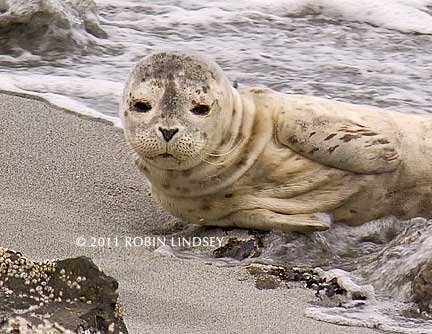
Sandy was only three weeks old, weighing 7.1 kgs (a third of normal body weight for a nursing pup), when she was rescued by Seal Sitters from a West Seattle beach on August 15, 2011 (photo right). She spent a lengthy 5 month rehab at PAWS, but was a robust pup when finally released at a harbor seal rookery in South Puget Sound. Through the combined efforts of PAWS, NOAA, SeaDoc Society and WDFW Marine Mammal Investigations, Sandy was fitted with the satellite tag in order to provide valuable data to researchers. The satellite revealed she stayed relatively close to the release point for the first few days, but then she began taking off on adventures - south to Olympia, north to the San Juans, circling Vashon, back to Olympia and Shelton, up to Edmonds a couple of times. After being in a small pool for so many months, it seemed as though she had the travel bug and appeared to be thriving in the wild (map below shows her travels). The last satellite hit was on the 27th.
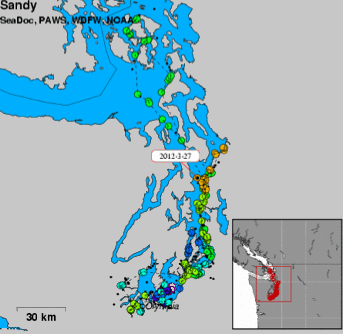
Sandy is not the only harbor seal with a West Seattle connection to die from fishing gear. A few days before we rescued her last August, we responded to a dead adult female on Beach Drive. The necropsy showed that the female had given birth within ten days or so and the cause of death was from fishing line and lure, twisting the female’s stomach and causing an agonizing death. A newborn pup we nicknamed Tiny died on another beach the same day as the necropsy. It is not beyond the realm of speculation that Tiny was this female’s pup and that fishing gear caused the death of both animals.
This is truly a very sad day. Special thanks to PAWS’ staff who nursed Sandy back to health and cared for her for so many months. For those of us who participated in her release, we will never forget the joy of seeing her swimming free in the Sound with that little yellow-green satellite hat. SS volunteers and Puget Sound residents signed up to receive SeaDoc Society email alerts and excitedly followed her movements online. To read more about Sandy and view the video of her release back to the wild, click here.
To learn more about the dangers of marine debris and how you can help, click here.
NOTE TO DIVERS:
If you are a diver and come upon animals who have died in derelict gear, we ask two things. First, please take a photograph and email a jpg to us. We will forward the photos to the appropriate person for a corresponding database - this will greatly help assess the true number of animals that perish each year. Secondly, please indicate the location of the derelict gear if you have lat/long finder and we will report it to the Northwest Straits Derelict Fishing Gear Removal Program which estimates that 50,000 animals are entangled and die each year in Washington waters just in shallow water nets and gear (excluding an unknown number in deep-water derelict gear). Harbor seals had by far the highest number of deaths among marine mammals in gear they removed. According to their website :
As of November 30, 2011, the Northwest Straits Initiative has removed 4,081 derelict fishing nets and 2,668 crab pots from Puget Sound, restoring 596 acres of critical marine habitat. Over 241,700 animals, representing more than 240 species, were found entangled in this gear.
Please spread this message among your diving community and make a difference for the marine mammals of Washington. Do not attempt to remove fishing gear - it is extremely dangerous. NW Straits has informed us that a diver drowned in Puget Sound a few years ago on a sport fishing line cleanup.
Satellite Sandy cruising the San Juan Islands
Mar/11/12 09:54 AM
The seal pup that Seal Sitters MMSN rescued from the beach in August is now cruising the San Juans. We know this because after a lengthy rehab at PAWS Wildlife Center, Sandy was fitted with a satellite tag and released at a harbor seal haul out south of Tacoma. She has been moving all over the region - Olympia, Shelton, Vashon Island, 3 Tree Point, West Seattle, Richmond Beach and now the northern islands. You can follow Sandy’s lengthy travels on SeaDoc Society’s dedicated webpage and receive email alerts when a satellite picks up her signal. Her movements enable biologists to learn more about seal pup behavior. The glued-on tag will fall off when Sandy sheds her fur coat in a few months.
PUPDATE 3/12
The latest satellite hits show that Sandy has opted to head back south and was pinged at the northeast tip of the Olympic Peninsula. This is a bit of a relief since we wonder if she is able to tell the difference between the vocalizations of the transient orcas who eat seals and that of the residents who prefer salmon. With no mom to have taught her the ins and outs of life in the wild, she is trying to figure things out on her on.
PUPDATE 3/12
The latest satellite hits show that Sandy has opted to head back south and was pinged at the northeast tip of the Olympic Peninsula. This is a bit of a relief since we wonder if she is able to tell the difference between the vocalizations of the transient orcas who eat seals and that of the residents who prefer salmon. With no mom to have taught her the ins and outs of life in the wild, she is trying to figure things out on her on.
Seal pups galore in West Seattle
Mar/08/12 07:58 AM

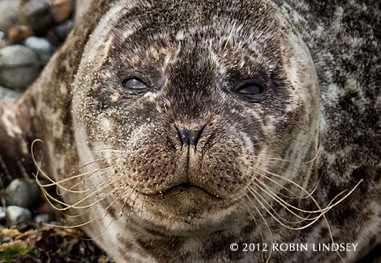
Sandy the satellite-tagged pup near Vashon Island
Feb/21/12 06:47 AM
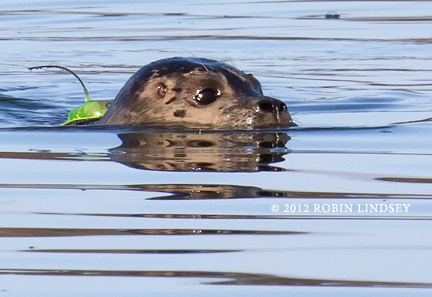
Keep your eyes peeled for a little seal pup with a yellow transmitter on her back. If you see her, please keep your distance and call our hotline @ 206-905-7325 (SEAL). Her movements are being studied by biologists and will give tremendous insight into the behavior of rehabilitated pups as they try to adapt to life back in the wild. SeaDoc has a web page devoted to Sandy here and you can receive email updates as to her locations and cheer her on. It is very exciting for volunteers and the public to be able to follow Sandy’s progress and see how well she is doing back in the Salish Sea.
Satellite Sandy spreads her wings in the Salish Sea
Feb/16/12 09:47 PM
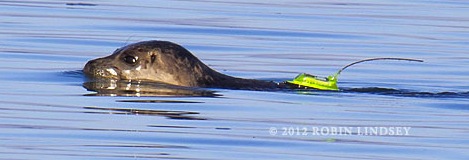
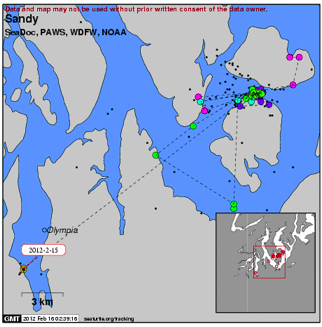
You can follow Sandy’s travels on SeaDoc’s website. In fact, you can even get an email alert when passing satellites pick up her signal. Check out Sandy’s dedicated page here. And, if you happen across a log boom, grab your binocs and see if there is a seal or two catching some zzzz’s - maybe you’ll even see Sandy with her fancy yellow hat!
Seal pup Sandy released back into the wild
Jan/31/12 05:52 PM

Sandy’s movements will provide ground-breaking information for biologists. She can be tracked by the public as well on SeaDoc Society’s website, which has a web page dedicated to her, showing a map of her cruising around South Puget Sound. In the photo above, Sandy swims in the wild with her new satellite hat. Tracking this animal would not be possible without the collaboration of several network groups which include: Seal Sitters MMSN, PAWS Wildlife Center, WDFW Marine Mammal Investigations, SeaDoc Society and NOAA’s Protected Resources Division.
PUPDATE: Feb 2/2012
We have had some folks with concerns that the satellite tag is somehow harmful for Sandy. The tag is applied with glue to Sandy’s pelt and will fall off when she sheds her fur during molting season in a few months. Most likely, the tag will fall off before then; however, in the interim, the satellite tracking will provide researchers with insights into foraging patterns, distances travelled by weaned pups and health and mortality data. This research will help other seal pups in the future.
